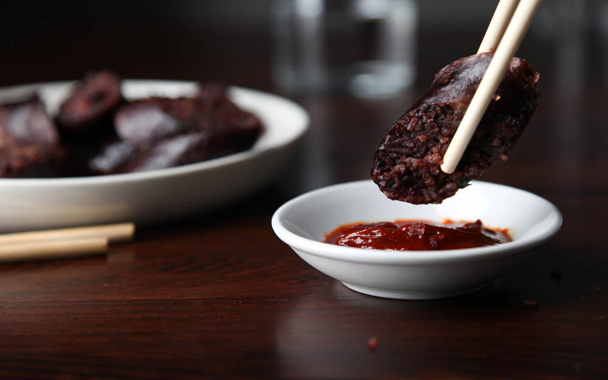I won’t be home for bedtime tonight,” I told my five-year-old, Iris. “I’m going out for Korean food.”
“I want to come along,” said Iris, who loves Korean barbecue and bibimbop.
“It’s a place that specializes in blood sausage.”
“Okay, you go, I’ll stay here with Mama.”
She needn’t have worried. Soondae (often spelled, hilariously enough, “sundae”) is among the least threatening of all blood-sausage varieties, because in its most common form it consists mostly of noodles—the same dangmyeon noodles used to make the beef and noodle stir-fry chap chae—bound with a bit of blood and barley and stuffed into a pork casing.
Korean food has more scenic byways than the average national cuisine. I’ve eaten a lot of it and am still frequently and pleasantly surprised, just as Gourmet contributor Jonathan Gold was when he recently went out for his first Korean blowfish stew at Dae Bok in L.A. Gold is the only person ever to win a Pulitzer for writing about ethnic restaurants. The cuisine that can surprise him has a serious back catalog.
This was my first soondae experience (at Green Garden restaurant, in a Seattle suburb), and I’d gladly do it again. As you may know, anything at a Korean restaurant with “bokkum” in the name is going to be loaded with garlic and gochujang (Korean hot sauce) to the point that it’s bright red. Ojingeo bokkum, for example, is that colorful stir-fry of squid and vegetables. So I was pleased when we settled on soondae bokkum, which arrived in a large bowl set on a hot plate. Somewhere between a stir-fry and a stew, it was full of the sausage itself, plus chewy rice cakes (tteok), noodles, slices of pork liver, and even a few vegetables.
The soondae was yielding, creamy, and comforting. Next time I’m bringing Iris.
Green Garden Korean Restaurant 15740 Aurora Ave. N., Shoreline, WA (206-361-7478)




 Pinterest
Pinterest


